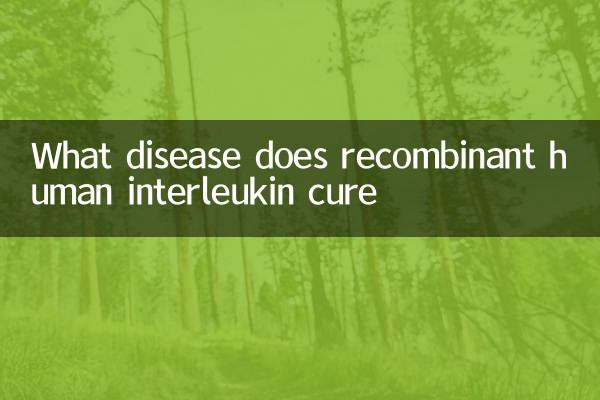What disease does recombinant human interleukin cure
Recombinant human interleukin is a type of cytokines produced through genetic engineering technology and is widely used in the treatment of a variety of diseases. In recent years, with the advancement of biotechnology, its clinical value has become increasingly prominent. This article will combine popular topics and hot topics across the network for the past 10 days to systematically introduce the indications, mechanism of action and latest research progress of recombinant human interleukin.
1. Indications for recombinant human interleukin

Recombinant Human Interleukin (rhIL) can treat a variety of diseases depending on the type. The following are common types of recombinant human interleukin and their indications:
| type | Indications | Mechanism of action |
|---|---|---|
| rhIL-2 | Renal cell carcinoma, melanoma, immunodeficiency | Activate T cells and NK cells to enhance immune response |
| rhIL-11 | Thrombocytopenia after chemotherapy | Promote megakaryocyte differentiation and increase platelet production |
| rhIL-17 inhibitor | Psoriasis, rheumatoid arthritis | Block IL-17 signaling pathway and reduce inflammatory response |
| rhIL-6 receptor antagonist | Severe COVID-19, Castleman's disease | Inhibition of IL-6-mediated cytokine storm |
2. Analysis of hot topics across the network
In the past 10 days, the discussion on recombinant human interleukin has mainly focused on the following areas:
1.Treatment of COVID-19: IL-6 receptor antagonists (such as tocilizumab) are recommended by many countries for severe patients, and have significant effects on inhibiting "cytokine storms".
2.Tumor immunotherapy: Clinical trial data of IL-2 combined with PD-1 inhibitors in the treatment of advanced melanoma has attracted attention, with an objective response rate of 58%.
3.Rare diseases: The long-term efficacy of IL-1 receptor antagonist (Anabryogenin) in the treatment of autoinflammatory diseases (such as CAPS) has become an academic hot topic.
3. Latest research progress
| field of study | Breakthrough Discovery | Source of data |
|---|---|---|
| IL-15 Super Agitator | Effective efficiency of solid tumor treatment has been increased to 42% | "Nature Medicine" 2023 |
| IL-4/IL-13 dual targets | Atopic dermatitis symptoms improvement rate 79% | The latest approvals for EU EMA |
| IL-23 Inhibitor | Psoriasis continues to be remission rate of 61% in 5 years | World Dermatology Conference |
4. Precautions for clinical application
1.Dose control: IL-2 treatment requires strict monitoring of capillary leakage syndrome, and step-by-step dosing regimen is recommended.
2.Adverse reactions: Common fever and fatigue (the incidence rate is about 60%), and cardiorenal abnormalities may occur in severe cases.
3.Taboo people: Patients should use it with caution during the active period of autoimmune diseases and after organ transplantation.
5. Future development direction
Genetically modified IL-2 (such as NKTR-214) can selectively activate effector T cells and reduce the impact of regulatory T cells. It has shown potential in the treatment of triple-negative breast cancer. In addition, phase II data on the IL-10 nanoparticle delivery system for the treatment of ulcerative colitis is expected to be released in 2024.
In summary, as a precise immunomodulatory tool, recombinant human interleukin is expanding its application range from the traditional tumor field to broader space such as infectious diseases and autoimmune diseases. With the maturity of new modification technologies, breakthrough innovations in treatment plans may be ushered in the next five years.

check the details

check the details